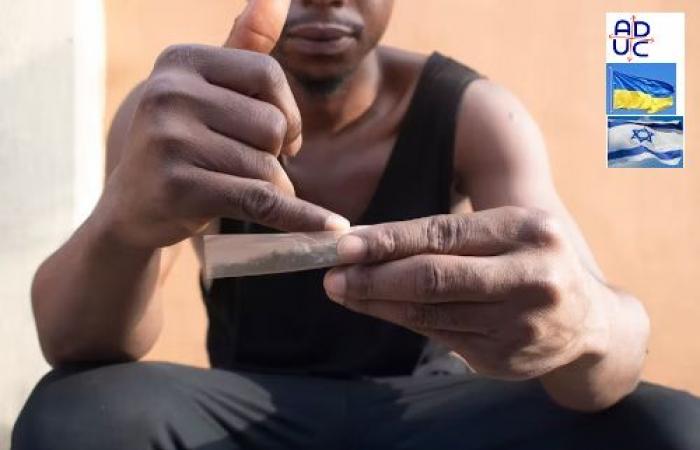In recent years, increased cocaine seizures in France and elsewhere and increased violence – such as the narcocides in Marseille – have drawn attention to the growing power of international groups involved in trafficking (particularly the cartels of South American groups , the Nigerian sects, the Mocro Mafia and jihadist groups).
Heroin, still consumed in France, even in rural areas, cannabis and drugs based on pregabalin have in common the fact that they arrive in France largely from Africa. They cross the Sahara outside the control of states after the Sahel, the “side of the desert” which includes Mauritania, Mali, Burkina Faso, Niger and Chad.
Cannabis, heroin, crack, even on the other side of the Sahara
What about the circulation and consumption of narcotics in the Sahel countries and, more generally, in West Africa?
A recent UNODC report shows the dramatic increase in cocaine seizures in the Sahel countries, which are on the shortest sea and land route from Latin America to Europe. These seizures increased from 13 kg per year in 2015-2020 to 1,466 kg in 2022 (mainly in Burkina Faso, Mali, Niger).
These countries are also transit zones for cannabis resin from North Africa, as well as drugs consumed as narcotics that follow the routes of the informal drug market and are distributed in the countries of the region, in particular from Burkina Faso.
Heroin from Asia arrives at ports in the Gulf of Guinea to continue north, as do new synthetic products from India and China.
From circulation to local production
While it was known that the circulation of drugs ultimately leads to local consumption, the discovery in Niger of laboratories producing crack, this “poor man’s cocaine”, reveals an active strategy by traffickers to create a market in Africa.
In the absence of quantitative studies on the population, qualitative research and data regarding users treated in healthcare facilities represent the main sources of knowledge – very limited – on the population’s consumption.
The quantities of tramadol seized in West Africa represent 95% of the quantities seized in illicit contexts worldwide. This pharmaceutical opioid is consumed as a stimulant by professions requiring stamina, such as motorcycle taxi drivers in Togo or Cameroon and gold miners in Senegal and Mali.
Drug use in the region is not just recreational: amphetamines and other psychostimulant products are rather used for performance and social integration purposes. Speeches at the conference “Social sciences and drugs in French-speaking Africa. Diversification of products, transformation of uses” in Dakar in May 2024 showed the extent of these uses.
They may also have a therapeutic purpose, fulfill a ritual or social function, or result from an addiction initiated by the uncontrolled prescription of an analgesic that the patient cannot stop and which he obtains on the informal market.
In West Africa, as in other continents where drug circulation is better known, we can understand the circulation and consumption of drugs only by addressing them differently by categories, which are consumed by different populations.
Addictions but also the other harmful effects of these products in case of abuse or sometimes from the first dose (toxicity, expression of psychological disorders, desocialization and social marginalization) are neither identified nor quantified precisely.
Concern about new drugs popular among young people
Recently, products widely used by young people have attracted media attention and concern from healthcare professionals, including the I want in Senegal, the lean in different countries, kuhadafi in Ivory Coast and kush distributed from Sierra Leone and Gambia to neighboring countries.
Proposed in the form of tablets distinguishable by their appearance, the I want Senegalese has been pharmacologically identified as MDMA (ecstasy) or its derivatives.
Lean it is a mixture of codeine syrup or tablets and soda, to which an antihistamine may be added (a treatment initially indicated for allergies). Lean it is analogous to the Purple Drink, originating in popular culture in the 1990s in the United States, which is still promoted by Senegalese and international rappers.
Khadafia mixture of alcoholic energy drink and Tramaking (combination of an opioid and a muscle relaxant), is consumed in smoking lounges where drug addicts meet in Ivory Coast.
Finally, kush is an inexpensive drug that appeared in 2016 in Sierra Leone. The composition of this product, the most consumed nationally, seems to have evolved. This term first designated varieties of cannabis with a high dosage of tetrahydrocannabinol (or THC, the main active ingredient of cannabis), then a mixture of marijuana, fentanyl, acetone and tramadol, which according to some rumors could contain human bones.
In a context of uncertainty about the composition of kush, which favors rumors or “urban legends” that penetrate medical-scientific circles, a recently published FTIR spectrometry study has highlighted the presence of synthetic cannabinoids and nitazenes (new opioids) in samples taken in Freetown (Sierra Leone) and Bissau (Guinea-Bissau).
These new products are more potent and more addictive than the THC in cannabis or opium, but remain in regulatory vagueness that allows them to escape scrutiny. Until they are listed and studied, the capacity to address their harm is limited, as in France.
In early April 2024, the president of Sierra Leone decided to make drug use a “national emergency” given the number of people who have become addicted and the hundreds of deaths among young people of all social classes who consume kush .
Risk reduction centers that must adapt: the example of Dakar
In Senegal, the results of the CODISOCS (Injecting Drug Consumers and Social Dynamics in Senegal) research project confirm the circulation of some of these products in multiple social environments.
The Dakar Integrated Addiction Treatment Center, which has been applying harm reduction and offering opioid substitution treatment with methadone for almost ten years, is a pilot center at the regional level. Created with the support of international organizations and the National AIDS Council, it has made it possible to diagnose, treat and prevent infectious transmissions (HIV, hepatitis virus, tuberculosis) among injecting drug users.
But consumption and risks have evolved considerably since its creation: users no longer use injections except exceptionally, also thanks to awareness-raising actions. Cannabis remains the most consumed narcotic, but its psychotherapeutic treatment protocol is not accessible to everyone and its effectiveness in Africa has not been validated.
As for new synthetic products and diverted drugs, they are less known by the healthcare team, made up of healthcare professionals and community mediators who have little influence among young consumers.
Finally, in Senegal, the legislative framework is still based on an essentially repressive approach. However, many actors in the fight against drugs (community, health, justice or security forces), overwhelmed and exhausted by ineffective repression, are convinced of the need to treat and help rather than incarcerate simple users, in line with the community campaign “Support don’t punish.”
Recommendations issued by experts in social sciences, addictions, etc.
Conference participants (one hundred social science researchers, drug addiction experts, health workers, community experts, institutional actors from ten West African countries) launched the Dakar Anti-Drugs Initiative in West Africa to address this critic situation.
These recommendations concern health and justice stakeholders, politicians, user associations and scientists. They begin by creating means of pharmacological and toxicological analysis to quickly identify circulating products and their adverse effects and inform communities, as well as providing antagonistic overdose treatments to frontline actors.
Researchers still need to mobilize to provide precise knowledge about consumption and responses across diverse social and cultural contexts, in collaboration with affected communities.
(Alice Desclaux – Anthropologue de la santé, TransVIHMI, Institut de recherche pour le développement (IRD) -, Khoudia Sow – Médecin, anthropologie médicale, coordinator de l’équipe Sciences sociales au Center régional de recherche et de formation à la prize en charge de Fann à Dakar, Sénégal (CRCF), Institut de recherche pour le développement (IRD) -, Rose André Faye – post-doctorante en anthropologie, Institut de recherche pour le développement (IRD) -, on The Conversation of 06/24/ 2024)
the association does not receives and is against public funding (even 5 per thousand)
Its economic strength lies in registrations and contributions donated by those who deem it useful
DONATE NOW






